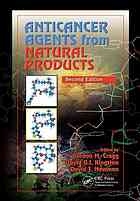

Most ebook files are in PDF format, so you can easily read them using various software such as Foxit Reader or directly on the Google Chrome browser.
Some ebook files are released by publishers in other formats such as .awz, .mobi, .epub, .fb2, etc. You may need to install specific software to read these formats on mobile/PC, such as Calibre.
Please read the tutorial at this link: https://ebookbell.com/faq
We offer FREE conversion to the popular formats you request; however, this may take some time. Therefore, right after payment, please email us, and we will try to provide the service as quickly as possible.
For some exceptional file formats or broken links (if any), please refrain from opening any disputes. Instead, email us first, and we will try to assist within a maximum of 6 hours.
EbookBell Team

0.0
0 reviews"The search for new lead compounds is a crucial element of modern pharmaceutical research. Natural products provided the only source of pharmaceuticals for thousands of years, and natural products have made enormous contributions to human health through compounds such as quinine, morphine, aspirin (a natural product analog), digitoxin, and many others. The potential of natural products as anticancer agents was recognized in the 1950's by the U.S. National Cancer Institute (NCI) under the leadership of the late Dr. Jonathan Hartwell, and the NCI has since made major contributions to the discovery of new naturally occurring anticancer agents through its contract and grant support, including an important program of plant and marine collections. Many, although not all, of the compound classes described in the following pages owe their origin in whole or in part to NCI support. In spite of the success of the natural products approach to anticancer drug discovery, as exemplified by the following chapters, in recent years their importance as a source of molecular diversity for drug discovery research and development has been overshadowed by newer chemical approaches currently in favor. These approaches include chemical ones which make heavy use of combinatorial chemistry, and biological ones such as manipulation of biosynthetic pathways of microbial metabolites through combinatorial biosynthetic techniques. It is thus worthwhile to review briefly the major reasons why natural products are so important. First, there is a strong biological and ecological rationale for plants and marine invertebrates to produce novel bioactive secondary metabolites"--Provided by publisher.
"The search for new lead compounds is a crucial element of modern pharmaceutical research. Natural products provided the only source of pharmaceuticals for thousands of years, and natural products have made enormous contributions to human health through compounds such as quinine, morphine, aspirin (a natural product analog), digitoxin, and many others. The potential of natural products as anticancer agents was recognized in the 1950's by the U.S. National Cancer Institute (NCI) under the leadership of the late Dr. Jonathan Hartwell, and the NCI has since made major contributions to the discovery of new naturally occurring anticancer agents through its contract and grant support, including an important program of plant and marine collections. Many, although not all, of the compound classes described in the following pages owe their origin in whole or in part to NCI support. In spite of the success of the natural products approach to anticancer drug discovery, as exemplified by the following chapters, in recent years their importance as a source of molecular diversity for drug discovery research and development has been overshadowed by newer chemical approaches currently in favor. These approaches include chemical ones which make heavy use of combinatorial chemistry, and biological ones such as manipulation of biosynthetic pathways of microbial metabolites through combinatorial biosynthetic techniques. It is thus worthwhile to review briefly the major reasons why natural products are so important. First, there is a strong biological and ecological rationale for plants and marine invertebrates to produce novel bioactive secondary metabolites"--Provided by publisher